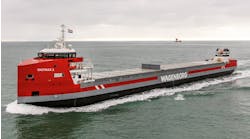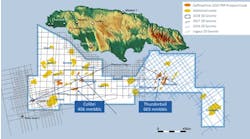With 40 tcf in gas results, industry looking to deeper waters
- Production testing and gas flaring over the Darfeel 1discovery in Egypt's Nile Delta. [4,912 bytes]
- Current gas discoveries in Egypt's Mediterranean play. [52,800 bytes]
The International Egyptian Oil Company (IEOC)/Amoco partnership recorded four additional gas discoveries during this short period, namely Akhen and Osiris in the Amoco-operated Ras El Barr Concession, and Tuna and Karous in the Agip/IEOC-operated Temsah Concession.
Agip/EGPC (Egyptian General Petroleum Corp.) successfully appraised the Darfeel gas discovery, which is now considered as a sizable field, drilled two additional new field discovery wells in the Pliocene, namely Nouras and Barracuda, and recently announced the new gas discovery of Nidoco 9 in the West Abu Madi Development Lease.
In the eastern part of the Mediterranean, PGS's 3D seismic activity continued in the BG-operated Eastern North Sinai Concession, and additional seismic surveys are under consideration by the industry. As far as development activity is concerned, Petrobel (Agip/EGPC) has successfully put onstream early in the year the gas fields of Wakar and Baltim South, the former being located in Agip/EGPC's Port Fouad Development Lease, the latter in Agip/IEOC's operated concession Baltim with Amoco as partner. Furthermore, an aggressive exploratory drilling campaign is currently under way in many concessions and development leases over the Mediterranean Shelf, mainly by Amoco, BG, Agip/IEOC, and Petrobel.
Since 1960s
Among the major E&P companies active in the area, the Italian group Agip, which operates through its affiliate IEOC (International Egyptian Oil Company) and the operating company Petrobel (50/50 Agip-EGPC) has, since the discovery of the giant Abu Madi gas field in the late 1960s to the present day, played a major role in unveiling the huge gas resources present in the Nile Delta Basin. Agip/IEOC currently holds 32,150 sq km of exploration acreage in the prolific Nile Delta Basin, and 2,600 sq km of development acreage whose aggregate gas production is about 280 MMcf/d gas, the largest gas production among the foreign investors in Egypt.IEOC pioneered gas exploration on the Egyptian Mediterranean Shelf with a tremendous five-year exploratory effort from 1981 to 1986. During that period, two significant gas discoveries were made, Port Fouad Marine and Wakar, which encountered hydrocarbons in the deep Miocene sequence, opening a new perspective for future exploration to the whole international gas industry. The acquisition during 1985 of the first 3D seismic ever shot in the Mediterranean Shelf of North Africa, totaling almost 900 sq km, reinforced Agip's and EGPC's expectations about the great gas potential of the area.
Favorable gas terms
Further to these results, in order to continue to encourage gas exploration, the Egyptian government introduced in the early 1980s the so-called gas clause into the agreements. This entitled the foreign partners to a profit on the gas discovered. The gas provisions were further improved in 1993, by linking the gas price to the oil price, thereby increasing the industry's desire to economically develop even marginal gas fields.These contractual improvements triggered a renewed effort by the industry in general, and by Amoco and Agip/IEOC in particular. This effort is still continuing. In the period 1992-1996 Agip/IEOC as operator drilled 19 consecutive successful exploratory gas wells which eventually resulted in the development leases of Port Fouad, Baltim South, Baltim North, Baltim East, Temsah and Denise, while Amoco, as operator in partnership with Agip/IEOC, discovered the sizable fields of Seth, Hapy, Akhen, and Osiris. These will most likely be converted into development leases by the end of this year.
The exploratory acreage of Wakar and Port Fouad was converted into a large development lease in mid-1994 and, since then, Agip's and EGPC's innovative development operations, carried out by the operating company Petrobel, proceeded very quickly with the Port Fouad gasfield going onstream only 24 months later.
The accomplishment of the very demanding engineering work resulted in the Port Fouad six slots platform, which has four producing wells and minimum production facilities. Yet, the platform is completely unmanned and is remotely controlled from the onshore Port Fouad Gas Center.
The development embodies high standards of safety and environmental protection with the application of both international standards and the requirements of Egyptian regulations. Particular attention was dedicated to selecting a pipeline route which minimized interference with shipping access to the Suez Canal.
The Wakar Field production was started up six months after Port Fouad, and the two fields are now producing at an overall rate of 125 MMcf/d gas and 5,800 b/d condensate, all achieved in record time.
Petrobel successes
Another record for Egypt was set by Petrobel, who put on production the recent significant discovery of Nidoco 9, located three km off the coast in the mid-Delta area, 25 days after having performed field tests. The discovery was developed by means of a monopod connected into the existing El Qara production facilities onshore. Nidoco 9 is currently producing at a level of 30 MMcf/d and 500 b/d condensate.This record is matching the one achieved by Petrobel in 1991 for the early development operations carried out on the Sinai oil field Ras Garra, the first offshore stand-alone field ever developed in Egypt in less than 16 months. The Agip-EGPC operating company also developed the Baltim South discovery of mid-1995, which was put on stream the first quarter of 1997, on behalf of the operator IEOC/Amoco.
The exploratory events that paved the way for today's impressive successes in the offshore Nile Delta basins were based on a huge 4,000 sq km 3D seismic acquisition program shot by Agip/IEOC as operator and Agip/EGPC over the concessions of Port Fouad, Temsah, and Baltim in 1992, 1995, and 1996, and seven key new field wildcats drilled in the northern Temsah Concession and Baltim Concession by IEOC during the period 1993-1996.
The 3D seismic acquisition put into evidence both the deep subtle traps in the Early Miocene sediments and the continuity and thick pays of the shallow Pliocene seismic anomalies, whose gas pools were directly detected by Agip by applying advanced and innovative seismic processing tools like amplitude extractions, 3D AVOs, and other seismic attributes.
IEOC pioneered gas exploration on the Egyptian Mediterranean Shelf with a tremendous five-year exploratory effort from 1981 to 1986. During that period, two significant gas discoveries were made, Port Fouad Marine and Wakar.3D results
The new field wildcats which reassured the industry about the huge gas resources present in the area were Temsah 3, Temsah 8, and Temsah NW 1, which upgraded the reserves of Temsah to the level of a major or even a giant gas field, and Baltim East 1, Baltim North 1, and Baltim South 1, which proved the continuity of the reservoir sandstones of the Abu Madi formation along a fairway 10 km wide and extending for more than 40 km into the sea. The Pliocene test Denise 1, drilled by IEOC in the Temsah Concession in mid-1995, encountered 100 meters of high porosity gas bearing sandstones and, by confirming the seismically derived models, opened a new perspective over the great potentiality of the Pliocene play.As a consequence of the aggressive exploration carried out in the onshore and offshore Nile Delta Tertiary Basin, gas reserves in that area have skyrocketed to the present industry estimates of 40 tcf, including the resources still to be discovered in the deeper water areas of the Mediterranean and the still poorly explored western and eastern offshore portion of the Delta Basin, while the figure of a total 50 tcf for the whole Egypt, which has been reported in the past, is not beyond the wildest dream of the explorationists.
More and more gas successes in the deep exploration of the Western Desert have in fact been announced by the companies more active in the area, namely Shell, Repsol, and the American Company Apache, while more gas is hopefully yet to come from the deeper areas of the Gulf of Suez and the frontier acreage of the Red Sea, where BG and Agip are the major players.
Copyright 1997 Oil & Gas Journal. All Rights Reserved.


